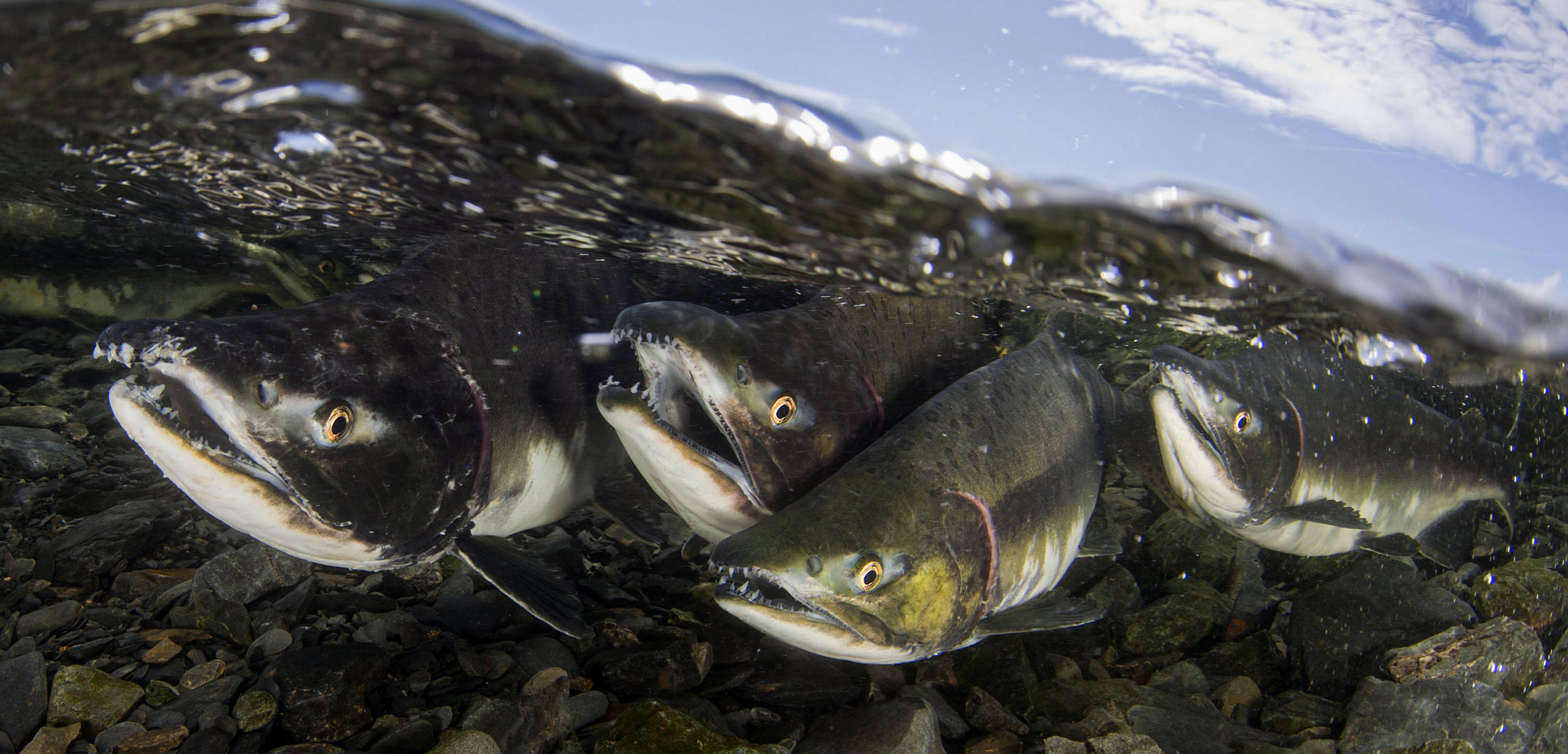Survivor: Salmon Edition
Will different salmon species adapt before the climate votes them off the island?
Article body copy
On a small, grassy point overlooking the lower Fraser River in southwestern British Columbia, a lone angler reels in his line. He checks his lure and gazes out over the broad ribbon of silty water flowing to the sea. Then he casts again. It’s a late August afternoon, and I’m traveling by boat with biologist Dave Scott through the estuary of what is considered one of the world’s greatest salmon rivers. But for the moment, there’s a stillness stretching over the water: the only disturbance is a trail of wakes our boat leaves behind. As we push downstream, I look back at the lone angler perched on the bank. Shoulders slouched, he stands at the water’s edge, line cast, waiting. But the river seems in no hurry to reward his patience.
Salmon tend to be few and far between here in the late summer season, but Scott, a salmon biologist with the Raincoast Conservation Foundation in British Columbia, also knows these are hard times on the river. Many of the Fraser’s wild salmon populations are in serious trouble, with steadily declining numbers, and Scott and his colleagues have embarked on a new project in the estuary to improve the survival of juvenile salmon. A few days ago, he invited me out on the water to see their progress. Earlier this afternoon, Scott, a lanky, outdoorsy, West-Coast millennial in a black T-shirt and forest-green cargo shorts, welcomed me and a photographer aboard a small motorboat in the historic harbor of Steveston, and the three of us set off.
Perched on the bank of the lower Fraser River, the village of Steveston is now a quiet suburb of Vancouver. But during the early 1900s, canneries crowded the Steveston waterfront, where they packed Fraser River salmon into tins that were shipped around the world. The village boomed, and locals took to calling it Salmonopolis. Now times have changed, and few people call it Salmonopolis anymore. Today, much of the fishing talk in Steveston is about conserving and protecting the Fraser’s dwindling salmon stocks.
As we cruise downstream, Scott gives me a short primer on the Fraser estuary. Each year, he explains, five species of Pacific salmon travel through the waters of the estuary. They have specific streams they call home, specific times they migrate out to sea, and specific routes to get there. In other words, most salmon are finicky, so habitats that all five species use are of great importance. The Fraser River estuary is just such a place.
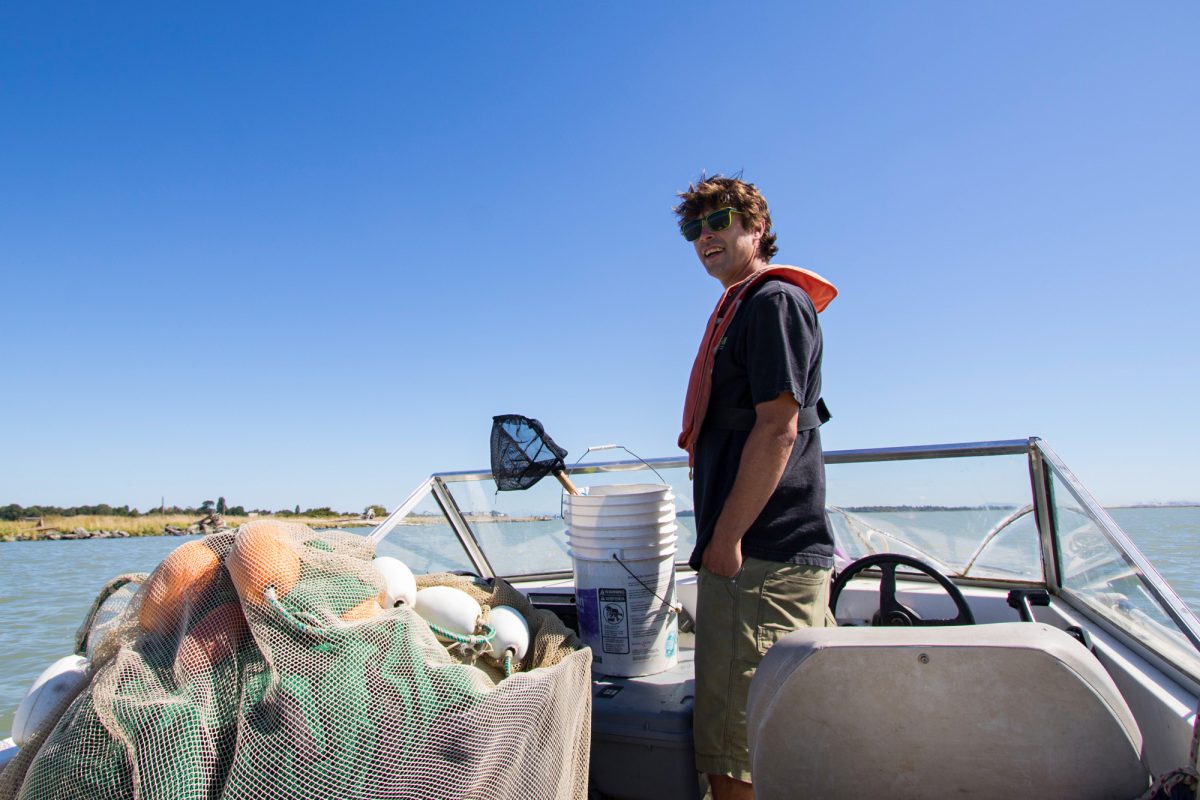
Salmon biologist Dave Scott heads out on the Fraser River in British Columbia to check a major new habitat restoration project for Pacific salmon in the estuary. Photo by Alice Sun
Before the arrival of European settlers, the estuary was a maze of water channels, sandflats, eelgrass beds, and marshlands. It served as a rest area and nursery for vast numbers of migrating juvenile salmon. But those numbers fell as the marshlands were drained for farms and housing developments, and stone jetties blocked water channels to some of the surviving wetlands. So Scott and his colleagues are looking for ways to give young salmon more access to the estuary’s remaining wetlands. They’re also trying to educate the public about the estuary and its critical importance to dwindling salmon stocks. “We’re trying to hit it on all angles,” Scott says, his brown hair tousled by the breeze.
But the Fraser isn’t the only salmon river in trouble. Scientists are also recording worrying declines in wild salmon stocks in other parts of the Pacific Northwest, too. Land development along freshwater habitats is a common problem in the region, but it’s only one of several factors shaping the current picture. Logging, landslides, and climate change also pose serious threats. Rising water temperatures, for example, can impact the intricate food webs that salmon depend upon in both rivers and oceans. And not all salmon species are affected equally, suggesting that genetic diversity within a species also plays an important part in the picture. Remarkably, one of the more genetically diverse and geographically widespread species, chinook salmon, seems to have fared the worst in North America over the past couple of decades.
Given all the changes that salmon populations have seen over the past century, scientists are now looking ahead with a new urgency, bracing for what the future may bring. And many are grappling with several questions. In a future shaped by rapid climate change, which salmon populations will do worse, and which will do better? And how will climate change affect the geographical distribution of salmon in the future? With this information in hand, researchers hope to develop new ways of protecting today’s salmon stocks—and prepare for tomorrow’s.
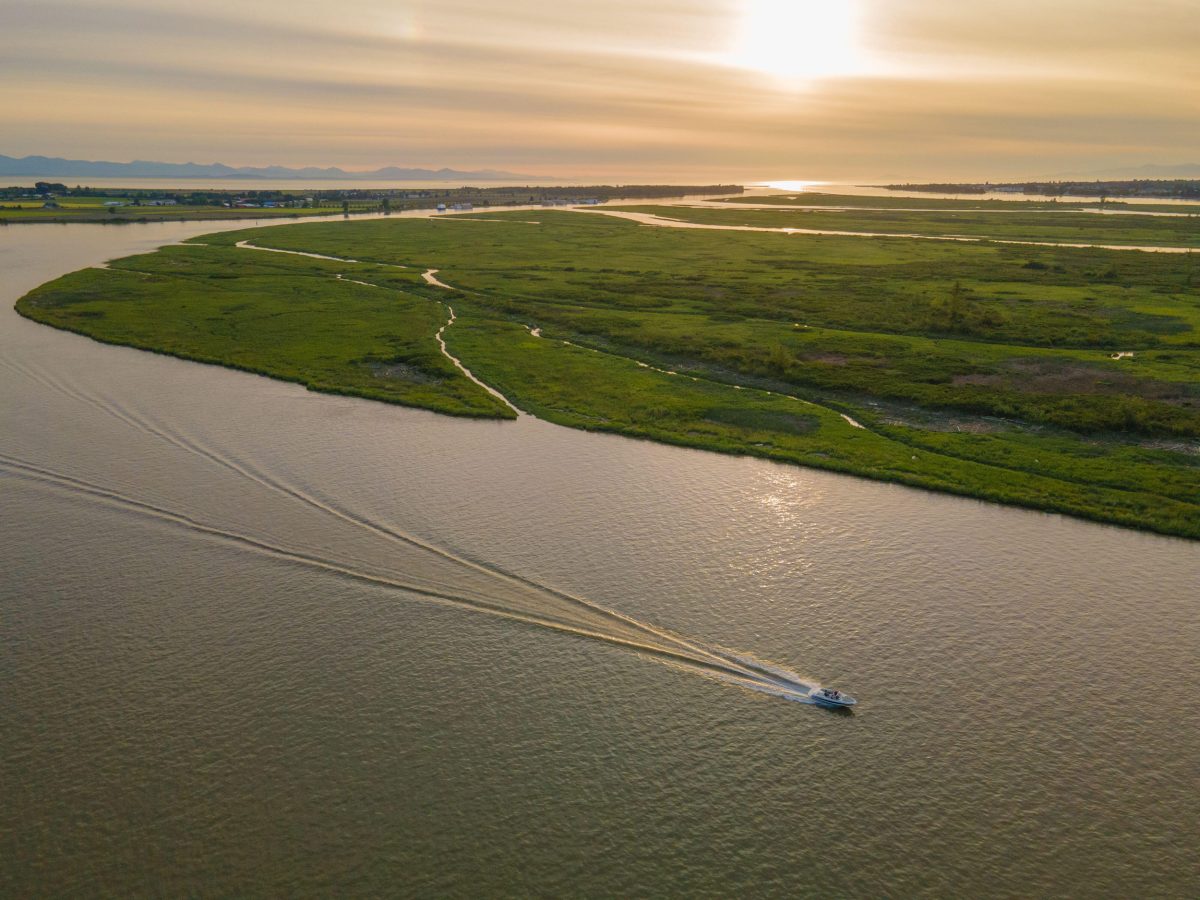
A boat cruises at sunset in the lower Fraser River estuary. The estuary is vital fish habitat: all five species of Pacific salmon pass through it on their journey to the sea. Photo by Fernando Lessa/Alamy Stock Photo
Much like social scientists, who look at a person’s formative years to understand their behavior and predict how they might act in the future, biologists say they are examining the evolutionary history of salmon as part of the research needed to envision the future of these iconic fish. Where, they ask, did Pacific salmon species evolve, and what experiences shaped their evolution and survival? In other words, what informed their formative years?
In the past, salmon had millennia to adapt to changes. Now we are forcing them to do so again in a matter of decades.
At the University of Washington in Seattle, ecologist Daniel Schindler has given much thought to the question of how salmon evolved and adapted to their local habitats. Over the past 25 years, Schindler has studied populations of Pacific salmon in many ecosystems in western Alaska, examining how they respond to both climate change and land-use issues. On the day we talk over Zoom, Schindler sports a brushy, graying beard after just returning from a four-month field season in western Alaska. As a principal investigator in the Alaska Salmon Program, the ecologist regularly takes graduate and undergraduate students north to monitor juvenile and adult salmon populations and check on how they are faring there. “That’s what keeps me in the business,” he says, one corner of his lips turned upward. “But teaching is fun, too.”
Schindler is fond of using analogies when he wants to make an important point about salmon. When our conversation turns to the question of how salmon will adapt to freshwater habitats during climate change, he begins by likening the process to a peanut butter and jam sandwich. One slice of bread is the landform—the mountains and river valleys. The other slice is climate. “The lumpy peanut butter is the habitat,” Schindler explains, “and the jam is the genetics. Then if you squeeze those two things together, the genetics are responding to the habitat, which is, in its own way, its own living entity.”
For salmon, the “living” habitats are landscapes shaped by the dynamic forces of nature—flooding, the movement of ice sheets and glaciers, and landslides. Almost half of the current North American range of Pacific salmon, for example, was blanketed in ice during the Last Glacial Maximum between 26,500 and 19,000 years ago. When the climate finally warmed, the glaciers retreated, carving out U-shaped valleys in the Pacific Northwest, altering water flow and temperature in downstream tributaries, and unlocking new areas for fish to colonize over a period of thousands of years. These momentous events changed the shape of riverscapes, selecting for salmon that could adapt to a dynamic environment. And more was to come. Erosion, land development, and many other factors have continued altering riverscapes over the centuries, creating new conditions for salmon to adapt to. Just where and how a species evolved profoundly shapes its genetic inheritance.
Among the Pacific salmon species, chinook have the greatest degree of diversity in terms of ecology, life history, and habitats. Often called king salmon by the public, a chinook typically weighs in at around 13 kilograms, though fishers have landed some as large as 50 kilograms, about one-third the weight of a panda bear. And while juvenile chinook dine mainly on insects and crustaceans, the adults feed primarily on other fish.
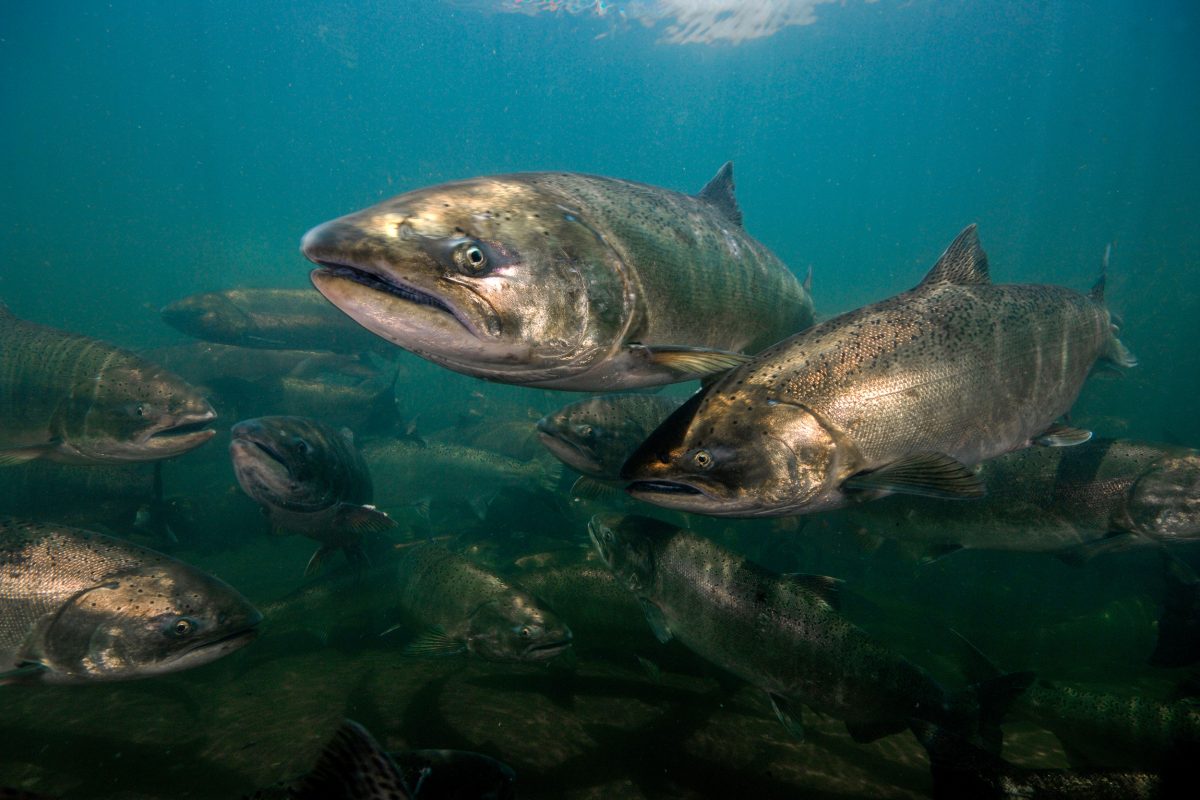
Long considered to be the royalty of the salmon world, chinook are in decline across much of the Pacific Northwest. Today, some scientists worry they could be the canary in a coal mine, sounding the alarm for other salmon species. Photo by Mark Conlin/Alamy Stock Photo
Along the west coast of North America, chinook have adapted to a wide range of environments. They can be found all the way from Northern California to the glacier-fed streams of Alaska. And they have a remarkably varied life history. Some set off for the ocean just a few months after they hatch; others spend a year or more in their natal streams before venturing to the sea. (These two groups are aptly named ocean-type and stream-type chinook, respectively.) In addition, some chinook can remain at sea for up to six years before migrating home; others stay there just a year.
Schindler likens chinook’s diverse populations and habitats to an investor with a varied financial portfolio. In the financial world, he says, wise investors don’t put all their eggs in one basket. Instead, they place their money in a variety of investments—stocks, bonds, real estate, and the like—and this strategy reduces their risk of losing everything in times of financial turmoil. By keeping a lot of options in the game, it’s more likely there will be a winner somewhere, Schindler notes. This is very similar to what chinook salmon have done. The rich diversity of its wild populations and habitats reduces the odds of the entire species being wiped out in the event of a disaster in one region.
With its varied portfolio, chinook salmon would look like a good bet for the future. But some statistics cast doubt on this. In 2020, the Committee on the Status of Endangered Wildlife in Canada designated seven chinook populations in southern British Columbia as either endangered or threatened. Much the same is true in the Columbia River watershed in the northwestern United States, where chinook populations may have lost more than one-third of their genetic diversity. More worrying still, the rate of young salmon returning as adults to rivers from California to Alaska over the past half-century has plummeted to one-third of earlier levels.
It’s a picture that puzzles many researchers. A myriad of variables impact salmon survival and it takes time and research to untangle them. Land use—from mining to damming and irrigation, for example—has affected chinook stocks in the Pacific Northwest at critical life stages, but it can’t be blamed for what’s happening in the northern latitudes. Many of Alaska’s rivers and streams remain almost untouched by development, and in certain areas, the amount of salmon habitat appears to be growing as melting glaciers produce new rivers and tributaries for salmon to colonize. Yet, wild chinook stocks are struggling in Alaska, far more than other salmon stocks. So what’s going on?
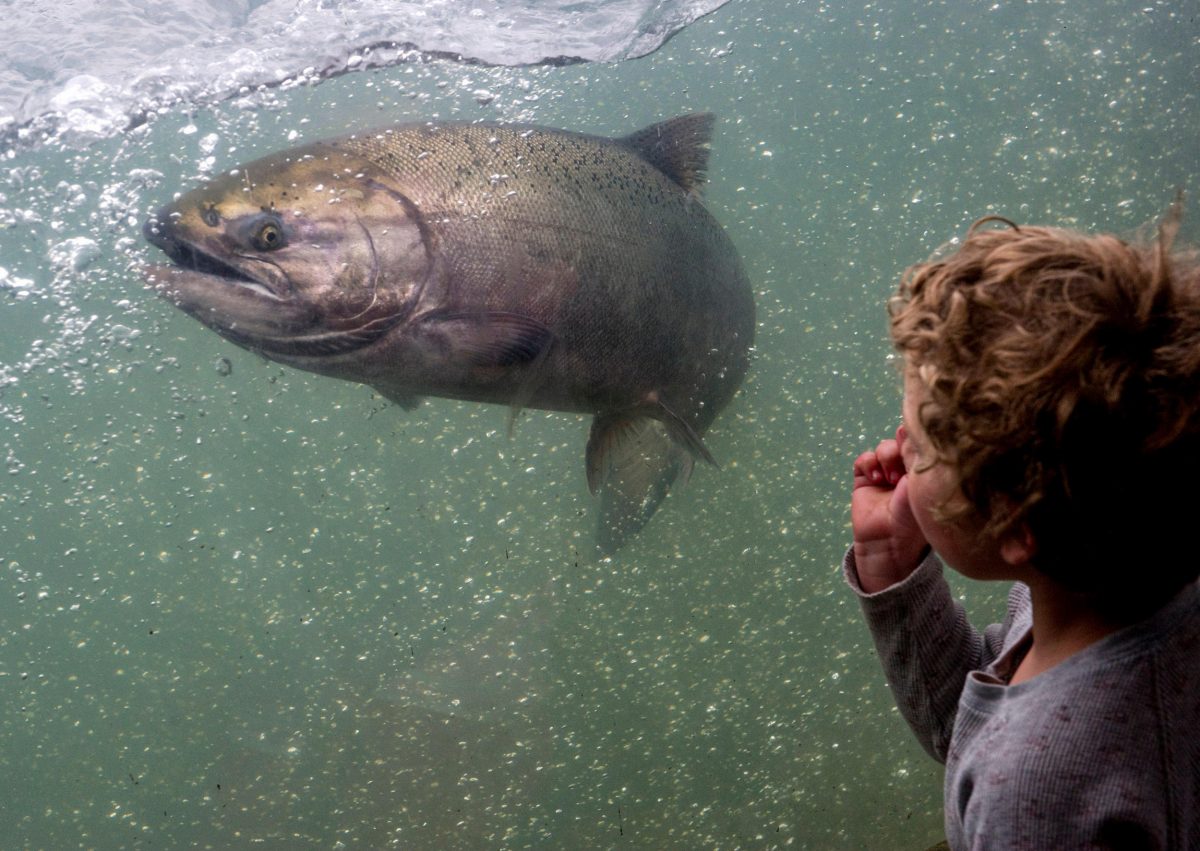
Through a viewing glass, a child gazes at a chinook in a fish ladder at the Winchester Dam in Oregon. Much of the decline of the chinook in Canada and the northern United States has been attributed to land development, particularly the damming of rivers. Photo by ZUMA Press, Inc./Alamy Stock Photo
At the University of British Columbia in Vancouver, fisheries scientist Scott Hinch rubs his chin in puzzlement. That’s “the $64-million question,” he says. Currently, studies suggest that much of the problem lies with what chinook stocks are eating in the ocean. The marine diet of some salmon species is changing, but it’s not easy to tease out the particulars. Food webs in the ocean are complex, he says. Predator levels change, or prey levels, or the number of fish that compete for the same prey, and these can affect the entire ecosystem. “It’s not as simple as saying the oceans are warmer,” Hinch observes.
For many ecologists, the fragile state of chinook salmon today is worrisome, given their diverse population stocks and their far-ranging distribution. And there is another puzzling side to this story. Pink salmon tend to be at the other end of the diversity spectrum. Their populations are relatively homogenous. But unlike chinook, pink salmon are an impressive success story.
The pink salmon is the bantam of the Pacific salmon family, with an average weight of two kilograms. Silvery in color as a juvenile, it later develops darker coloration and its flesh eventually turns pink as a result of its marine diet of shrimp and krill, both of which are rich in a reddish-orange pigment. Then, shortly before spawning, the males undergo yet another transformation, developing a large hump of connective and bony tissue near the dorsal fin. This bulge has given rise to a popular name for the species—humpback, often shortened to just humpy.
The pink has a very different life history from the genetically diverse chinook, although the two species evolved in broadly similar latitudes. Pink salmon lay their eggs in coastal habitats, rarely venturing far into the watershed, and the juveniles spend little time in fresh water, heading off to the ocean relatively quickly. Moreover, pink salmon have a fixed, two-year life span. They spawn, migrate, return, and die all within two years, and that often translates into an odd-year–even-year return cycle. Depending on the run, returns can fluctuate widely: odd years will see a flood of returning pinks, even years not so much. Or vice versa. Whether odd or even, however, the year with bumper numbers of pinks has an impact on the ocean food web. Pinks outcompete other species for food.
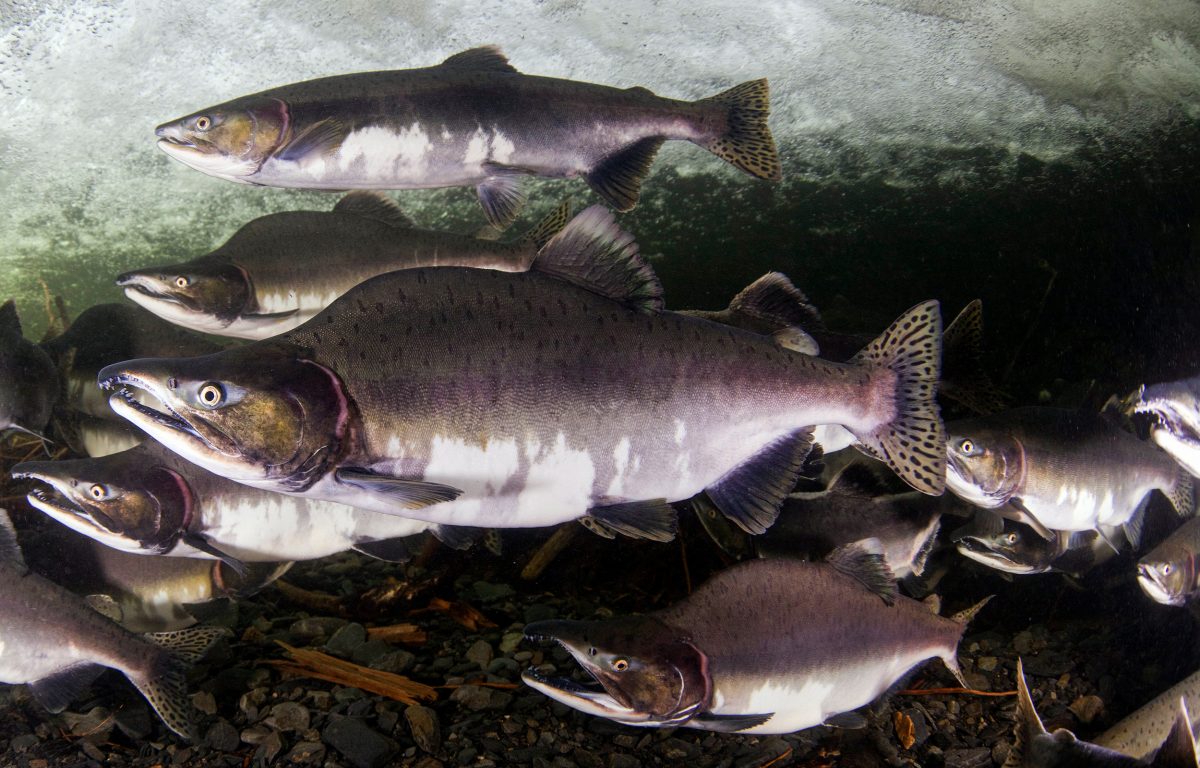
Nicknamed humpies due to the appearance of the males before spawning, pink salmon are highly resilient and appear to colonize new habitats with ease. These pinks are migrating through Prince William Sound, Alaska, where glacial retreat has accelerated over the past few decades, exposing new, pristine freshwater habitat. Photo by Chris and Monique Fallows/Minden Pictures
Pinks, however, get relatively little love from foodies in North America, compared with chinook or sockeye. There’s a good reason for that. Pinks put much of their energy into growing quickly, whereas chinook and sockeye take more time to grow and store more of their energy as fat. And in the culinary world, the fat content of a salmon translates into taste. Pinks, Schindler says, “just aren’t as luscious and juicy and delicious as a nice sockeye or chinook.”
Still, pink salmon have a lot going for them. They are accustomed to wandering and they aren’t picky about which stream they spawn in. They’re adept at colonizing unfamiliar rivers, and they need only a year and a half at sea before returning home to complete their life cycle—traits that make pink salmon reproductive machines.
And it shows. The pink is the most abundant Pacific salmon species. Between 1990 and 2015, more than 400 million pink salmon roamed the North Pacific Ocean and into the Bering Sea annually, far outnumbering chum and sockeye salmon there. But this reproductive success has a serious downside. Pink salmon are now outcompeting other species for food. In the southern Bering Sea region, for example, pinks are extremely abundant in odd years, and they gobble up vast quantities of the small crustaceans that other salmon species and seabirds need for survival. Some researchers think a similar scenario is taking place in the North Pacific, which could contribute to declining numbers of chum and chinook in the region, as well as the diminishing body size of chinook there: they’re just not getting enough to eat. For their size, pinks are stronger swimmers. In addition, they grow more quickly, head to the ocean sooner, and have a higher food consumption rate than their fellow salmon.
For all these reasons, pink salmon may well hold the winning lottery ticket for the future. Certainly, they are the salmon of the present. But their penchant for roaming and colonizing has created a new set of problems in places such as Norway, which is home to native populations of Atlantic salmon.
Just how pink salmon ended up in Norway is a tale that begins in the old Soviet Union. During the 1950s, someone in the Soviet Union came up with the idea of introducing pink salmon to the White Sea, a nearly landlocked finger of the Arctic Ocean along Russia’s northwest coast. The idea may have been to boost local commercial fisheries, “but this was back in the Khrushchev days, so exactly why they did what they did—that’s difficult to know,” says Henrik Hårdensson Berntsen, a salmon researcher with the Norwegian Institute for Nature Research, on a recent Zoom call. A clean-shaven man in a button-down shirt, Berntsen has been trying to piece together exactly what happened.
In 1957, Soviet scientists introduced pink salmon fry from Sakhalin, a Russian island north of Japan, to rivers that drained into the White Sea. The researchers then continued stocking these rivers with pink salmon eggs over the next two decades, and the program led to large catches in the Soviet rivers during most odd years. But the fish failed to establish breeding populations, probably because they could not adapt to the cold polar waters of the White Sea. So the Soviets eventually switched sources, taking eggs from pink salmon populations in the River Ola, north of Sakhalin. Then in 1999, the stocking project suddenly ended, likely because it was deemed a failure and due to the politically turbulent time in Russia.
Berntsen thinks fishers continued to catch pink salmon in rivers draining into the White Sea. In addition, some evidence showed that the fish also ranged farther north and west—into the Barents Sea and the North Atlantic. This suggested that pink salmon were breeding in the wild after all. Then, in 2017, something startling happened. Norway saw a huge spike in the number of pinks in its northern rivers. Some researchers estimated that more than 10,000 were in northern Norway, and Berntsen thinks that number is likely an underestimate, since the Norwegian fisheries management agency was taken off guard by the surging numbers and likely failed to record many catches.
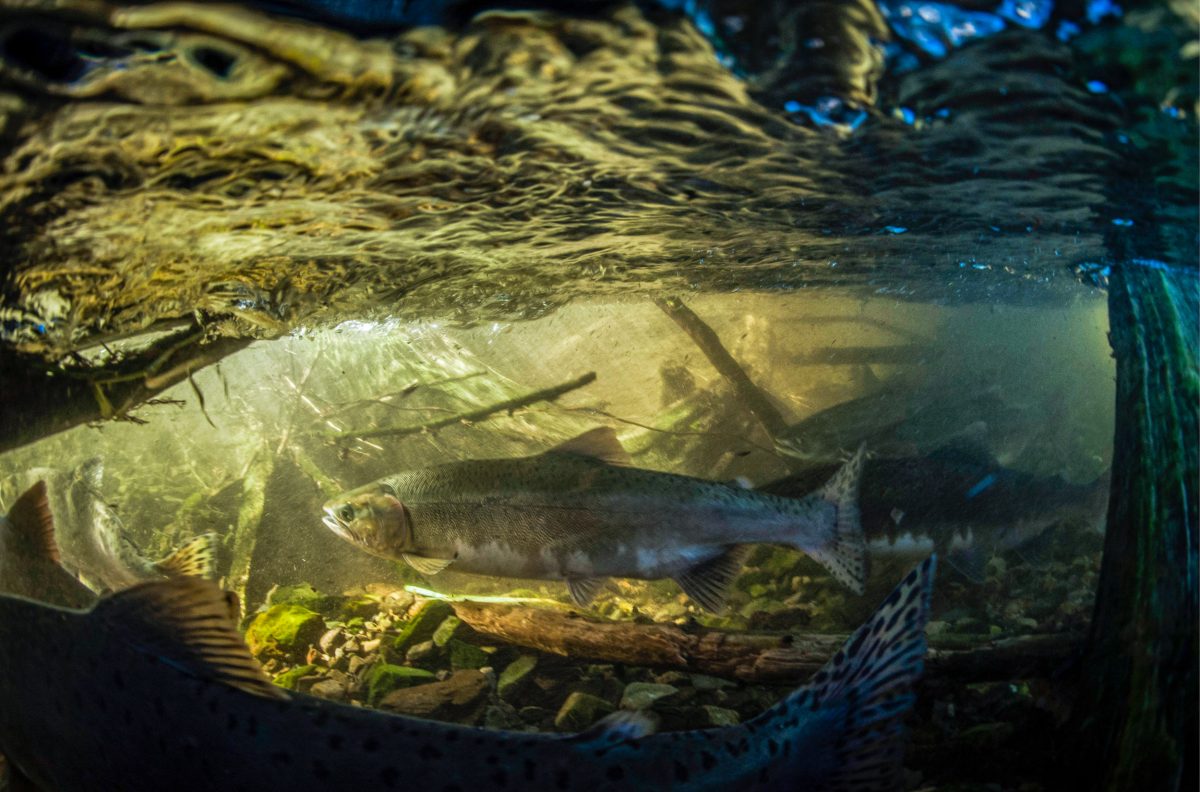
Pink salmon return to spawn along a streambed in one of the Shantar Islands off Russia’s east coast. During the 1950s, Soviet scientists introduced pink salmon from Sakhalin island, north of Japan, to the White Sea, where they probably began breeding in the wild. Photo by ITAR-TASS News Agency/Alamy Live News
Even more surprising was the appearance of pink salmon on the other side of the Atlantic in 2017—in Newfoundland and Labrador. Some researchers think these fish may be traced back to the Soviet project in the White Sea. Although no one knows how they got all the way to Canada’s east coast, it’s possible they migrated across the Atlantic Ocean from newly established populations in the United Kingdom and Ireland. Hinch and others think pinks are the weeds of the salmon world. Give them an opportunity to colonize a new area, and they will often take it and excel.
Indeed, they could be doing too well in Norway. When the Norwegian government recently studied the possible impact that pink salmon could have on the country’s wild and farmed salmon, it listed several major concerns—introduction of pathogens carried by the pinks, growing competition between the pinks and the native Atlantic salmon for food and habitat, and declining water quality in some rivers when large numbers of pink salmon return to spawn, leaving behind their decaying carcasses.
Then, as northern waters warmed over the years, researchers recorded another big spike in pink catches in Norway in 2019. According to Berntsen, this surge could indicate that the fish has now established its two-year life cycle in Norway, a possibility that fits with research findings from other northern regions. Scientists monitoring rivers and streams around the northern Bering Sea between 1995 and 2018, for example, recently found some evidence suggesting that warming freshwater temperatures contribute to higher survival for pink salmon.
But Berntsen cautions against drawing conclusions too quickly. Other factors could be at play, too. Hypothetically, he says, an increase of even 0.2 °C in the sea might be very beneficial for the prey of pink salmon, thereby increasing the food supply. Or a warming ocean could be detrimental to marine predators of pinks, such as whales and sharks. Just as the odd-year abundance of pink salmon in the North Pacific affected an entire ecosystem and the survival of other species, a slight change in conditions in the waters off Norway might tilt the ecosystem there in favor of the pinks.
But while warming temperatures in northern European waters might be helping pink salmon, a changing ocean off Canada’s west coast could spell serious trouble for other salmon species.
Tucked in the middle of an unusually quiet and empty forestry building at the University of British Columbia, the water pumps and other equipment in Scott Hinch’s lab can be heard from the hallway outside. The fisheries scientist has spent much of his career studying adult salmon migrations, and in a day’s time, he will be inducted into the Royal Society of Canada for his research. Hinch greets me and lets slip that he has to work on his acceptance speech for the ceremony after my visit. Still, he’s made time to show me the performance tests that he and graduate student Natalie Butler are running in the lab.
Hinch shows me four fiberglass troughs, each filled with water and about 125 young chinook salmon. All the fish are stream-type chinook and all are just under a year old: they were obtained from hatcheries in British Columbia’s Shuswap region.
The experiments are designed to test the thermal tolerance of the young fish, and Hinch hopes this work, along with research he’s done on other populations and other life stages, will shed light on chinook salmon in a future shaped by climate change. The water in each of the fiberglass troughs is kept at a specific temperature: 15 °C, 18 °C, 20 °C, or 24 °C. The three coolest temperatures reflect the range that chinook salmon have encountered both in historical times and today, while the warmest represents what they might soon experience. For the past two to three weeks, the juvenile fish have been acclimatizing to the water temperature in their respective trough.
Hinch and his team have already completed one experiment, which showed that some young chinook could tolerate waters as warm as 29 °C to 31 °C for a short period of time. Now the researchers are testing something more ecologically relevant—how long the young fish can swim at a specific temperature. To do this, they move fish from the fiberglass troughs into swim tunnels kept at a specific temperature between 15 °C and 24 °C, and they observe what happens. The experiment entails a lot of waiting. “Natalie just sits here and watches all day as they fail,” Hinch says, laughing. And by “fail,” he means the fish stop swimming and go belly-up. When that happens, she moves the struggling fish to a recovery tank.
So far, they’ve learned that many young fish fail pretty quickly when they’re made to swim at a higher temperature—even if they had previously acclimatized to that temperature. “Just because … fish can acclimate, doesn’t mean they can ecologically perform at those temperatures,” Hinch says. And outside the lab, in a fast-flowing river or stream, the fish need to be able to perform.
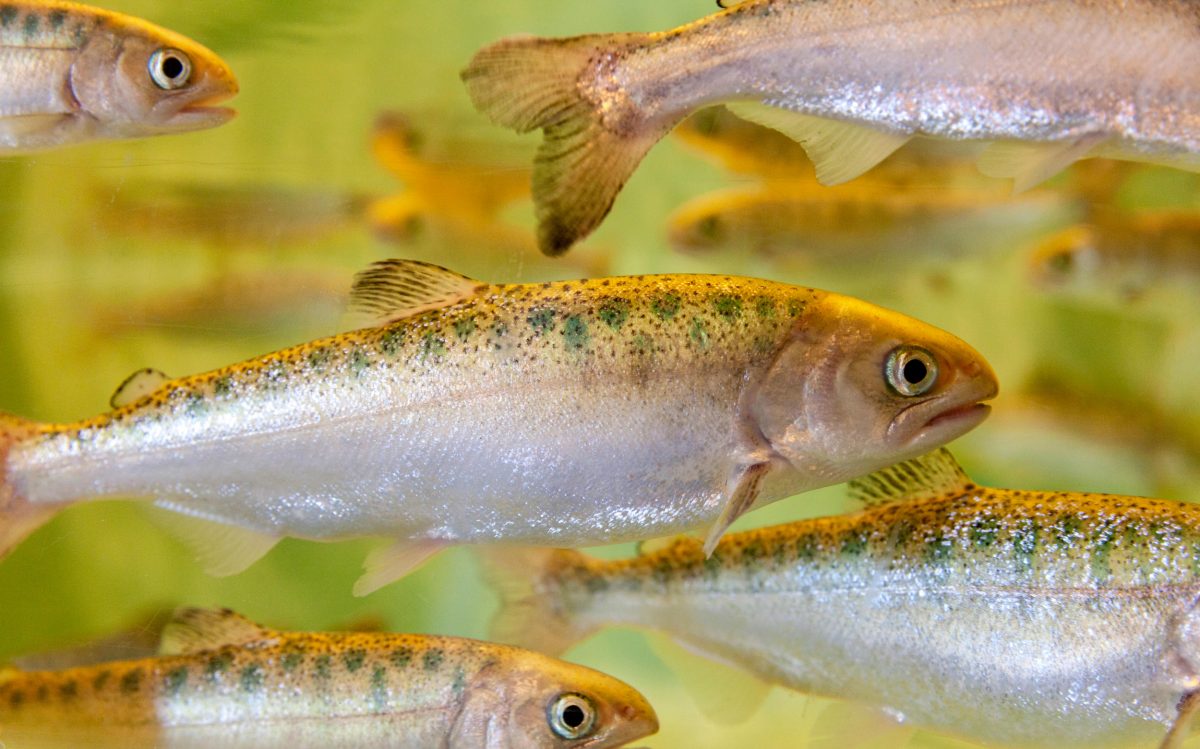
Juvenile chinook salmon gleam in a tank at the Seattle Aquarium in Washington State. At the University of British Columbia, fisheries scientist Scott Hinch is studying the thermal tolerance of juvenile chinook to see how they may fare in a time of climate change. Photo by Images By T.O.K./Alamy Stock Photo
These results could indicate a troubled future for many stream-type chinook salmon. But they don’t mean that all chinook populations face serious peril. With a varied “financial portfolio,” chinook salmon have many different options in the game, many different populations, and some of these produce juveniles that migrate to the sea within their first three months of life, thereby reducing their dependence on freshwater habitats. This poses the question: does the future of salmon lie with populations that spend little time in streams and rivers, heading off to the ocean at the first opportunity? That’s certainly the strategy of the pink salmon.
Hinch notes that researchers have long considered oceans to be “risky” places for salmon, since marine environments abound in big, hungry predators such as sea lions and sharks. But what was once considered “safe” or “risky” habitat seems to be shifting. In the Pacific Northwest, humans have urbanized, developed, and dammed much of the freshwater habitat that once provided safe havens and nurseries for juvenile salmon. And that may mean that the ocean is looking better.
So might pink salmon, with their brief sojourns in fresh water, have taken a gamble that’s paying off? Hinch thinks so. Pink salmon may not be the most consistent species, with their steeply fluctuating numbers shaped by their two-year life cycle, but they are the most productive today.
Moreover, things are also looking bright for them down the line. According to some climate models, the glaciers of western North America will lose 80 percent of their ice over the next 80 years, creating brand-new landscapes and shifting the ranges of many species. In the 1970s, pinks were the first salmon to colonize Glacier Bay in Alaska after the ice retreated from the fjord. Today, climate change is forcing salmon to adapt to dynamic habitats once again, at a pace they’ve never had to before. And to date, pink salmon have shown they’re able to keep up.
But that doesn’t mean it’s time to throw in the towel on other salmon species. Just ask Dave Scott. In 2016, he and his colleagues at Raincoast began working on ways to help struggling coho and chinook salmon in the Strait of Georgia and the Salish Sea. Scott focused on assisting juvenile salmon in accessing the marshlands of the Fraser estuary before they ventured off to sea. He wants to show me the habitat restoration project that resulted.
As we cruise downstream through the estuary, Scott steers the boat with one hand and points out some of the sights along the way. Some 15 minutes later, we arrive at a spot along the Steveston Jetty, an eight-kilometer-long rock wall that runs parallel to the bank of the Fraser.
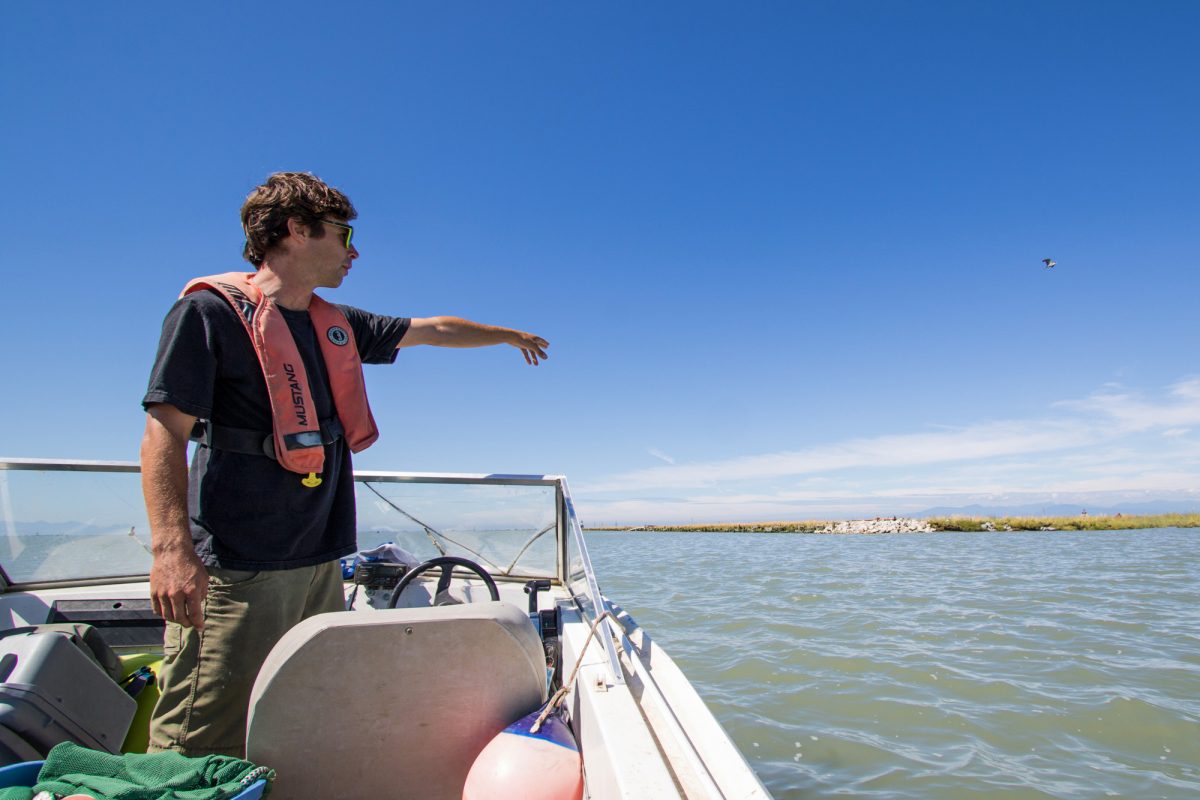
Along the Fraser River, Dave Scott points to a newly constructed breach in the eight-kilometer-long Steveston Jetty. The breach serves as an off-ramp, allowing young migrating salmon to exit the Fraser River and reach the marshes in the estuary. Photo by Alice Sun
Constructed roughly a century ago, the jetty acts much like a guardrail on a highway. It guides the flow of ships through the water channel and keeps them from straying into the marshland beyond the riverbank, keeping them on course between the river and the sea. But the construction of the jetty also had an unforeseen consequence. It prevented many young migrating salmon from reaching the maze of marshlands, streams, and mudflats beyond—habitats the fish need in order to rest and adjust to salt water before entering the ocean. In essence, the jetty blocks off some of the access to Sturgeon Bank for the young fish. The Fraser River, Scott says, is “the highway, and we’re trying to give them some off-ramps.”
To create those “off-ramps,” Scott and his colleagues drew up plans to build a few large holes in the jetty, allowing juvenile salmon to swim into the adjacent wetlands. Starting in 2018, a crane was barged to three parts of the jetty. It dug out holes nearly 50 meters wide and stabilized the bottom of each channel with two layers of rock. “We basically rebuilt the jetty here with an opening,” Scott says.
Scott waves at some of his team members, who are standing in waders on grassy mudflats near the opening, clipboards in hand. They have set up a net in the newly made channel, ready to catch any fish as they travel through this breach. Then they release them. But this August afternoon, as water temperatures reach 19 °C in the estuary, few young salmon are seeking out the channel. It’s too late in the season. Earlier in the spring, however, when the waters were a favorable 7 °C, the team caught as many as 300 juvenile chinook and chum salmon a day, each taking the new off-ramp into neighboring wetlands. “We couldn’t believe our eyes as we kept retrieving them,” Scott noted in an article on the Raincoast Conservation Foundation website.
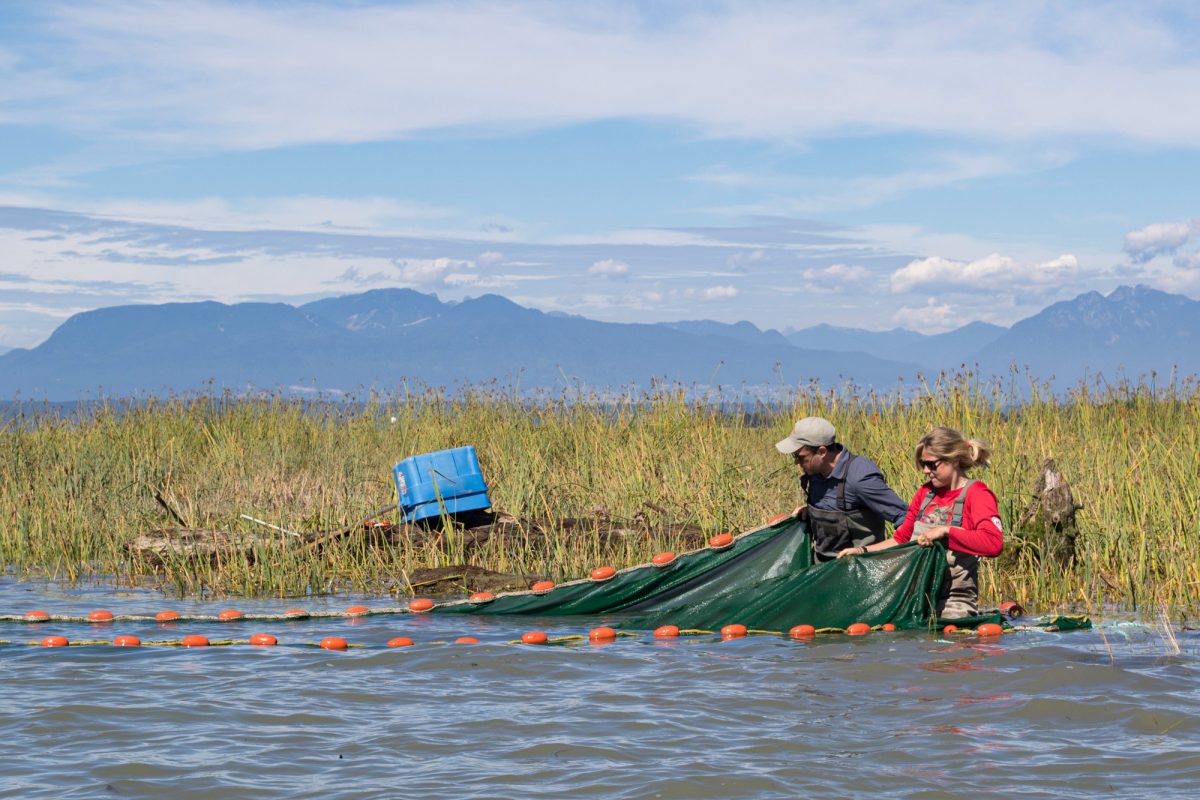
For a sampling project, students working with the Raincoast Conservation Foundation maneuver a net across one of the new breaches in the Steveston Jetty. In the spring, the team caught, counted, and released as many as 300 juvenile chinook and chum salmon per day using the breach—a clear measure of success. Photo by Alice Sun
Reducing barriers to wetlands and improving access to vital habitat in the Fraser estuary is only one small part of the work that needs to be done to conserve the Fraser River’s famous salmon, however. Much more remains, and it’s clear that—much like the salmon—we are on a tight deadline.
If we can’t find a way to slow the pace of climate change and give Pacific salmon a chance to adapt to the brave new world of the Anthropocene, then we might all have to get used to the idea of fewer Pacific salmon species in the world.

